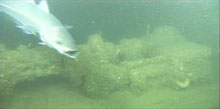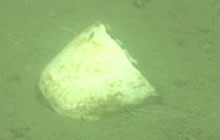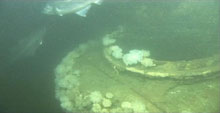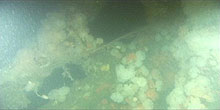
Pollock swim around a windlass, a device used to raise and lower the anchor. Photo courtesy NOAA/NURC-UConn/The Science Channel. Click image for larger view.
Artifacts as Educational Treasure
Sept. 16, 2003
Bruce Terrell
Senior Archaeologist
National Marine Sanctuary Program, NOAA
It’s a rare occurrence when I am conducting an archaeological survey on a historic shipwreck that I am not asked, “Did you find any treasure?”
Typically, I have to answer “Yes, but not in the way you assume.” This week’s treasure was in the information we gathered videotaping the steamship Portland with the high-definition camera on the ROV (remotely operated vehicle). All artifacts were left in place, just as they were when the Portland came to rest on the seabed more than a century ago. Their undisturbed context will tell us much about the steamship's crew and passengers as we assess the crystal clear images in the months to come.

This delicate cup sits in an area that was probably the ship’s galley. Photo courtesy NOAA/NURC-UConn/The Science Channel.Click image for larger view.
These objects will help tell the stories of the voiceless people who perished in the Portland’s demise. We located the steam-powered winch and capstans in the bow. The Portland’s deckhands might have used them to maneuver cargo booms, doing their jobs in the unconcerned routine of “just another trip” that fateful November Saturday. The orderly kitchen and storeroom on the main deck is now a jumbled mass of delicate ceramic plates and teacups, while coarse stoneware bowls can be found elsewhere on the wreck. These items are testimony to the company’s desire to cater to the tastes of the first-class passengers and to the durability of the crew’s workmanlike utensils. The galley stove, on which the ship’s last meal was prepared, sits in the midst of a nest of fishing nets, which snagged the wreck and probably ruined some fisherman’s day.

Today’s dive revealed that the smokestacks have not survived. The sidescan images showed the cast-iron chimneys that supported the thinner metal stacks. Photo courtesy NOAA/ NURC-UConn/The Science Channel.Click image for larger view .
These artifacts not only spark the imagination, but move the archaeologist to understand patterns of human behavior. They illustrate distances between social strata, meaningful acts by the actors in the drama, and even the more ignoble side of human nature.
Artifacts also tell us about the cultures they came from, who made them and who used them. They may have much to say about the wealth (or lack of it) that their owners or users possessed. Examining the craftsmanship of an artifact may inform whether it was expensive or cheap, useful or wasteful, and even safe or dangerous. Artifacts can be interpreted on as large a scale as an engine or an entire ship, or as small a scale as a copper pipe or a doorknob.

Murky water prevents a clear view of the diamond-shaped walking beam, part of the mechanism that powered the paddlewheels. Photo courtesy NOAA/NURC-UConn/The Science Channel.Click image for larger view.
It has been said that for every day spent conducting archaeological work in the field, the researcher must put in five days in the lab analyzing, conserving, and reporting. Our analysis will go on for some time as we work to understand the meaning of the Portland’s objects. We expect that the ceramics will tell us about the economic and social strata of the crew and passengers. The walking beam engine, auxiliary donkey boiler and engine, and the ventricular web of copper steam pipes will tell us about the people who built and operated passenger steamers. All of this, taken together, will be the true “treasure” of the Portland -- a ship that continues to fascinate the public, and an important maritime heritage of the Stellwagen Bank National Marine Sanctuary.

















